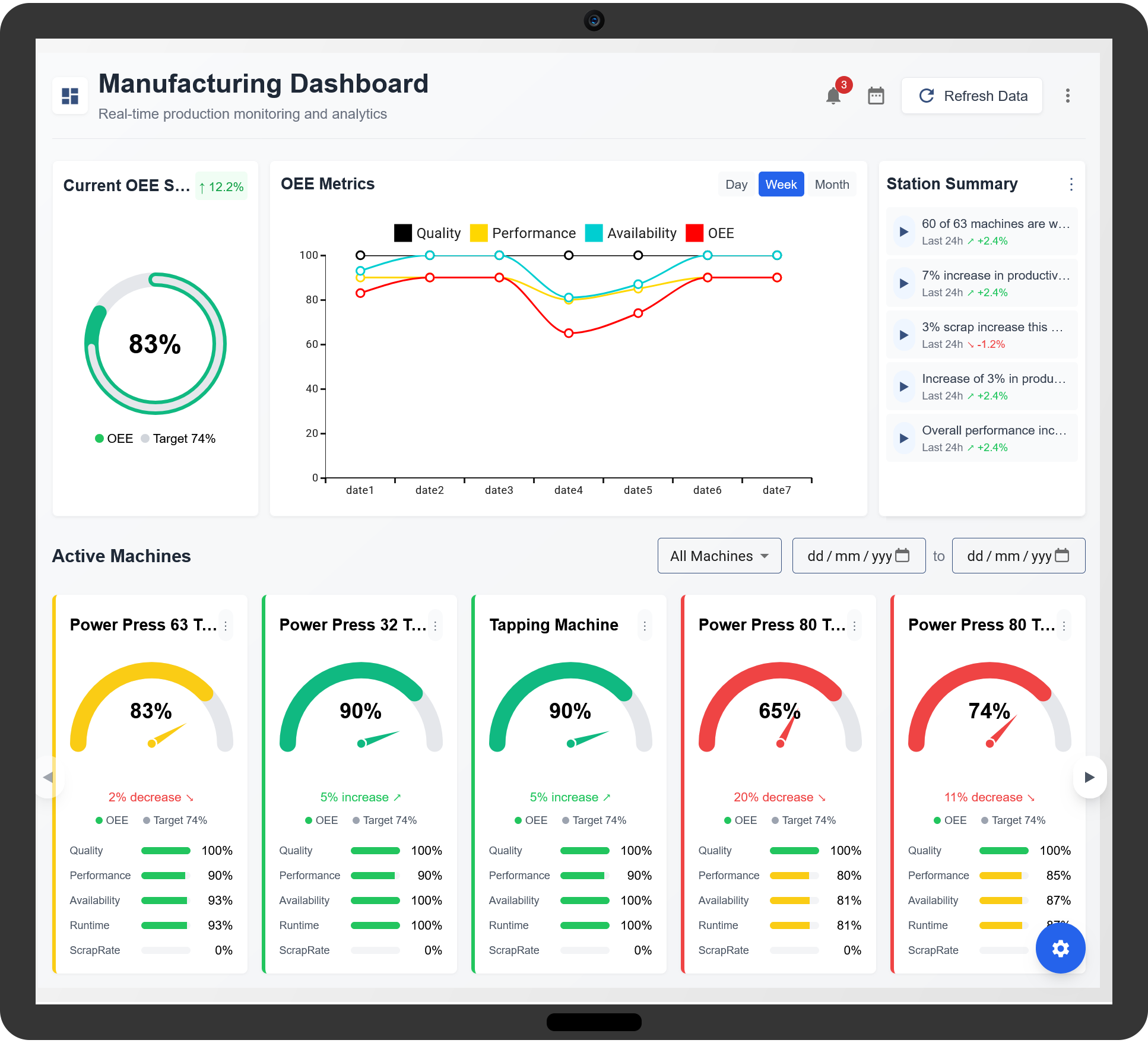Overall Equipment Effectiveness (OEE) is a crucial metric in lean manufacturing that helps businesses measure the efficiency and productivity of their equipment. By integrating OEE with lean principles, manufacturers can minimize waste, improve performance, and enhance product quality. OEE software further streamlines this process by providing real-time monitoring, automated data collection, and actionable insights.

1. Understanding OEE in Lean Manufacturing
Lean manufacturing focuses on reducing waste and maximizing value for the customer. OEE aligns perfectly with lean principles by identifying areas where waste occurs, such as unplanned downtime, slow cycle times, and production defects. The three core components of OEE—availability, performance, and quality—allow manufacturers to assess how effectively their equipment operates within a lean framework.
- Availability: Measures the percentage of scheduled production time that equipment is actually operational.
- Performance: Evaluates whether machines are running at their optimal speed.
- Quality: Determines the proportion of defect-free products produced.
By tracking these factors, manufacturers can implement lean strategies to improve efficiency and eliminate unnecessary losses.
2. The Role of OEE Software in Lean Manufacturing
OEE software plays a key role in lean manufacturing by automating the collection and analysis of production data. Instead of relying on manual tracking methods, businesses can use OEE software to gain real-time visibility into their operations. Key features of OEE software include:
- Automated Data Collection: Reduces human error and ensures accurate tracking of equipment performance.
- Downtime Analysis: Identifies the root causes of machine stoppages to minimize unplanned downtime.
- Production Monitoring: Provides real-time insights into cycle times and output levels.
- Quality Control Integration: Helps detect and prevent defects early in the production process.
- Reporting and Analytics: Generates detailed reports for continuous improvement and decision-making.
By leveraging OEE software, manufacturers can ensure that their lean manufacturing initiatives are data-driven and continuously optimized.
3. How to Improve OEE in Lean Manufacturing
Improving OEE requires a structured approach that aligns with lean principles. Below are key steps to enhance OEE in a lean manufacturing environment:
Step 1: Identify and Eliminate Downtime
Machine stoppages, setup changes, and maintenance issues contribute to availability losses. Tracking downtime reasons and implementing preventive maintenance schedules can help reduce disruptions.
Step 2: Optimize Production Speed
Reducing cycle time without compromising quality is essential for improving performance. Analyzing machine speed, identifying bottlenecks, and adjusting workflow processes can increase efficiency.
Step 3: Minimize Defect Rates
Quality losses occur when defective products require rework or are discarded. Implementing real-time quality monitoring and root cause analysis can help reduce production waste.
Step 4: Implement Continuous Improvement Strategies
Regularly reviewing OEE reports and involving employees in problem-solving sessions fosters a culture of continuous improvement. Lean methodologies such as Kaizen and Six Sigma can further enhance OEE.
4. Benefits of OEE in Lean Manufacturing
- Higher Efficiency: Ensures that equipment is utilized effectively to maximize output.
- Reduced Costs: Minimizes waste and operational expenses by identifying inefficiencies.
- Improved Quality: Reduces defect rates and enhances product consistency.
- Increased Productivity: Optimizes production schedules and minimizes downtime.
- Data-Driven Decision Making: Provides actionable insights for better process control and continuous improvement.
5. The Future of OEE in Lean Manufacturing
As lean manufacturing evolves, OEE software will continue to play a vital role in driving efficiency and process optimization. The integration of AI, machine learning, and IoT-based monitoring systems will further enhance real-time tracking, predictive maintenance, and automated decision-making. Manufacturers that embrace these technologies will gain a competitive edge by maximizing OEE and achieving sustainab
OEE Lean
What is OEE in Lean Manufacturing?
OEE (Overall Equipment Effectiveness) is a key metric in Lean Manufacturing that measures equipment efficiency by evaluating availability, performance, and quality.
Why is OEE important in Lean Manufacturing?
OEE helps identify inefficiencies, reduce waste, and improve productivity, aligning with Lean principles of continuous improvement.
How is OEE calculated in a Lean environment?
OEE is calculated using the formula: Availability × Performance × Quality, expressed as a percentage to assess overall efficiency.
What are the three key factors of OEE?
The three key factors of OEE are availability (uptime), performance (speed efficiency), and quality (defect-free production).
How does OEE help eliminate waste in Lean Manufacturing?
OEE helps reduce the Lean Manufacturing wastes of downtime, defects, and inefficiencies by pinpointing areas for improvement.
What is the ideal OEE percentage for Lean operations?
An OEE score of 85% or higher is considered world-class in Lean Manufacturing, but most operations aim for at least 60-70%.
How does downtime affect OEE in Lean Manufacturing?
Downtime reduces availability, leading to lower OEE scores and decreased productivity.
How can OEE software enhance Lean Manufacturing?
OEE software automates data collection, provides real-time insights, and helps manufacturers make data-driven decisions for Lean improvements.
What role does automation play in OEE tracking?
Automation ensures accurate and real-time OEE tracking, reducing human error and improving response times to inefficiencies.
How can OEE be used to improve productivity?
By analyzing OEE data, manufacturers can address bottlenecks, improve machine performance, and enhance production flow.
What are the common challenges in OEE implementation?
Challenges include data accuracy, resistance to change, and integrating OEE tracking with existing Lean processes.
Can OEE software integrate with existing manufacturing systems?
Yes, most OEE software solutions can integrate with ERP, MES, and other industrial systems for seamless tracking.
How does real-time OEE monitoring benefit Lean operations?
Real-time monitoring allows quick responses to production issues, reducing downtime and increasing efficiency.
What is the difference between manual and automated OEE tracking?
Manual tracking requires operators to log data, while automated tracking provides real-time insights with minimal human intervention.
How can OEE support continuous improvement in Lean Manufacturing?
OEE provides valuable data for ongoing improvements, helping teams implement Lean strategies effectively.